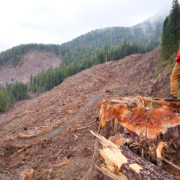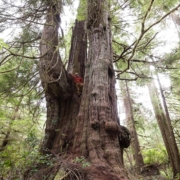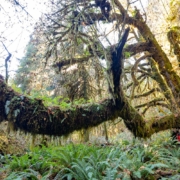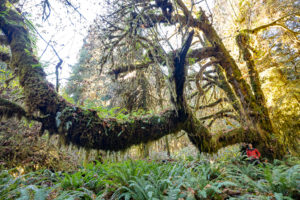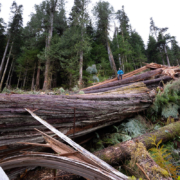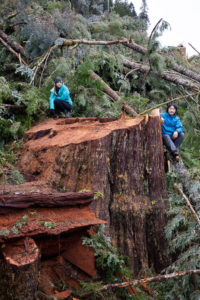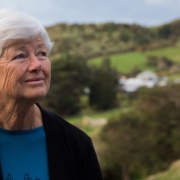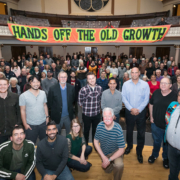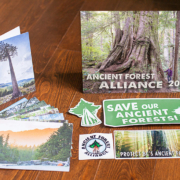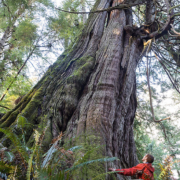New IMAX Film by Renowned Canadian Video Artist to Highlight Vancouver Island’s Endangered Old-Growth Forests
The magnificent but endangered old-growth forests of Vancouver Island are about to get a large-scale national audience on IMAX screens across Canada as the film Embers and the Giants premieres at the Images Festival in Toronto this week (Thursday, April 18) and later this fall in IMAX cinemas across Canada in Victoria, Sudbury, Edmonton and Montreal.
The film is part of a program of work entitled Outer Worlds, a series of five IMAX commissions from leading Canadian media artists, each of whom have created films in a cinematic genre typical of IMAX films: larger-than-life landscapes. Two of the films will feature the endangered old-growth forests of Vancouver Island near the town of Port Renfrew, in the unceded territory of the Pacheedaht First Nation band:
Embers and the Giants, by internationally renowned Canadian artist Kelly Richardson, a professor of Visual Arts at the University of Victoria and on the board of advisors of the Endangered Ecosystems Alliance, presents an endangered old-growth forest during last light, articulated by thousands of floating embers of light. Initial impressions may be that we are witnessing a rare, exceptionally beautiful display of fireflies. Then again, human intervention may be at play, suggesting a time when we’ll need to amplify the spectacle of nature in order to convince the public of its worth.

Richardson is known for creating hyper-real digital films of rich and complex landscapes that have been manipulated using CGI, animation and sound. Her projects have received major international acclaim, having been featured in the National Gallery of Canada, in galleries around the world, in an official Canada 150 exhibition, and in the upcoming IMAX film series.
Her most recent project and work has previously been highlighted in various news media:
See: : https://www.timescolonist.com/islander/capturing-the-art-of-nature-and-change-1.23144042
and https://www.sookenewsmirror.com/news/port-renfrews-avatar-grove-featured-in-national-imax-series/
and https://www.cheknews.ca/victoria-artist-showcase-port-renfrew-old-growth-forests-imax-project-405493
Forest, by Leila Sujir, Chair of the Studio Arts Department in the Faculty of Fine Arts at Concordia University, is another feature of the project. Her subject will be the Central Walbran Valley, an area on Vancouver Island that is scheduled for clear-cut logging. Over the past decade, Sujir has been experimenting with stereoscopic 3D video, extending the viewer into the space of the moving image.
Over the years, Vancouver Island’s old-growth forests have drawn considerable attention from the artistic community, including Emily Carr who produced pieces depicting the old-growth trees, giant stumps, and forests of the region in the first half of the 20th century; scores of renowned artists who contributed to the best-selling art book “Carmanah: Visions of an Ancient Forest” (300,000 copies sold) in 1990; and increasing numbers of artists and filmmakers in recent years featuring the ancient forests around Port Renfrew, including Richardson and Sujir.
“I relocated to Victoria in 2017 after living and working in England for 14 years in order to be closer to the magnificent old-growth forests. After visiting Avatar Grove during a work trip in the fall of 2016, I was overwhelmed by my experience of those ancient stands, which was a huge influence in my decision to apply for a professorship at the University of Victoria where I now work. My most recent project, Embers and the Giants, features the old-growth forests in this region. Through my partners with the Outer Worlds IMAX project, I hope I can contribute to efforts to raise awareness about their outstanding beauty and the plight to protect what remains.”
“We’re excited that such high-caliber artists and film producers will feature the endangered old-growth forests of Vancouver Island through the most spectacular medium – IMAX technology – on a national scale,” stated Ken Wu, executive director of the Endangered Ecosystems Alliance. “The old-growth forests around Port Renfrew, still largely endangered, are clearly continuing to impress increasing numbers of people -not only tourists, but acclaimed artists as well.”

“The old-growth forests around Port Renfrew, referred to these days as Canada’s ‘Tall Trees Capital’ that attracts thousands of tourists from around the world, are an international treasure with some of the largest and oldest living organisms on the planet. Sadly, most are on the verge of being turned into giant stumps. All large-scale exposure and awareness raising, including through creative media, are greatly welcome!” stated TJ Watt, Ancient Forest Alliance campaigner and photographer.
The campaign to protect the old-growth forests around Port Renfrew, in the Avatar Grove, Central Walbran Valley, Jurassic Grove, Eden Grove (adjacent to “Big Lonely Doug”), Edinburgh Mountain, and Mossome Grove, has enlisted a ground-breaking alliance of environmental activists and diverse allies involving numerous businesses, labour unions, city and town councils, artists, conservation groups, and others, calling on the British Columbian provincial government to protect old-growth forests and to ensure a sustainable, second-growth forest industry.
More BACKGROUND Information on BC’s Old-Growth Forests
Old-growth forests are vital to sustaining unique endangered species, climate stability, tourism, clean water, wild salmon, and the cultures of many First Nations. On BC’s southern coast, satellite photos show that at least 79% of the original, productive old-growth forests have been logged, including well over 90% of the valley bottoms where the largest trees grow. Only about 8% of Vancouver Island’s original, productive old-growth forests are protected in parks and Old-Growth Management Areas (see maps and stats at: https://16.52.162.165/ancient-forests/before-after-old-growth-maps/). Old-growth forests – with trees that can be 2000 years old – are a non-renewable resource under BC’s system of forestry, where second-growth forests are re-logged every 50 to 100 years, never to become old-growth again.
The BC government regularly spins the statistics on how much old-growth remains on Vancouver Island by:
- Including vast tracts of marginal, low-productivity bog and subalpine forests with small stunted trees of low to no timber value; failing to include contextual stats on how much used to originally exist (ie. How much has already been logged…ie.80%) of the productive old-growth forests
- Removing vast tracts of cut-over private corporate forest lands (still under provincial management) from their logging stats
- Combining stats of Vancouver Island’s remaining old-growth forests of the milder, southern coast with the old-growth forests of the colder, northern coast (ie. the Great Bear Rainforest) which are different (eg’s. they lack most of the really big trees and some of the biodiversity and ecosystem types found farther south; are far more extensive due to a more recent history of logging and more rugged terrain; and have largely been protected in recent times as a result of massive international forest products boycotts by Greenpeace in the 1990’s followed by almost 2 decades of negotiations, which has not occurred for most of Vancouver Island’s forests).
In recent times, the voices for old-growth protection have been quickly expanding, including numerous Chambers of Commerce, mayors and city councils, forestry unions, conservation groups, and First Nations across BC who have been calling on the provincial government to expand protection for BC’s remaining old-growth forests.
The Endangered Ecosystems Alliance, Ancient Forest Alliance, and BC conservation groups are calling on the BC government to develop science-based legislation to protect old-growth forests, to enact regulations and incentives to ensure a sustainable, value-added second-growth forest industry, and to support First Nations land use plans and the sustainable economic development and diversification of the communities as an alternative to old-growth logging.


